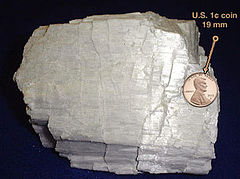Wollastonite
| Wollastonite | |
|---|---|
 |
|
| General | |
| Category | Silicate mineral |
|
Formula (repeating unit) |
Calcium silicate, CaSiO3 |
| Strunz classification | 9.DG.05 |
| Crystal system |
Triclinic Monoclinic polytype exists |
| Crystal class | Pinacoidal (1) (same H-M symbol) |
| Space group | P1 (1A polytype) |
| Unit cell | a = 7.925 Å, b = 7.32 Å, c = 7.065 Å; α = 90.055°, β = 95.217°, γ = 103.42°; Z = 6 |
| Identification | |
| Color | White, colorless or gray |
| Crystal habit | Rare as tabular crystals—commonly massive in lamellar, radiating, compact and fibrous aggregates. |
| Twinning | Common |
| Cleavage | Perfect in two directions at near 90° |
| Fracture | Splintery to uneven |
| Mohs scale hardness | 4.5 to 5.0 |
| Luster | Vitreous or dull to pearly on cleavage surfaces |
| Streak | White |
| Diaphaneity | Transparent to translucent |
| Specific gravity | 2.86–3.09 |
| Optical properties | Biaxial (-) |
| Refractive index | nα = 1.616–1.640 nβ = 1.628–1.650 nγ = 1.631–1.653 |
| Birefringence | δ = 0.015 max |
| 2V angle | Measured: 36° to 60° |
| Melting point | 1540 °C |
| Solubility | Soluble in HCl, insoluble in water |
| References | |
Wollastonite is a calcium inosilicate mineral (CaSiO3) that may contain small amounts of iron, magnesium, and manganese substituting for calcium. It is usually white. It forms when impure limestone or dolostone is subjected to high temperature and pressure sometimes in the presence of silica-bearing fluids as in skarns or contact metamorphic rocks. Associated minerals include garnets, vesuvianite, diopside, tremolite, epidote, plagioclase feldspar, pyroxene and calcite. It is named after the English chemist and mineralogist William Hyde Wollaston (1766–1828).
Some of the properties that make wollastonite so useful are its high brightness and whiteness, low moisture and oil absorption, and low volatile content. Wollastonite is used primarily in ceramics, friction products (brakes and clutches), metalmaking, paint filler, and plastics.
Despite its chemical similarity to the compositional spectrum of the pyroxene group of minerals—where magnesium and iron substitution for calcium ends with diopside and hedenbergite respectively—it is structurally very different, with a third SiO4 tetrahedron in the linked chain (as opposed to two in the pyroxenes).
...
Wikipedia
